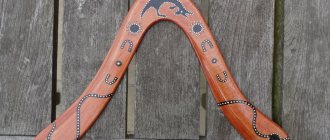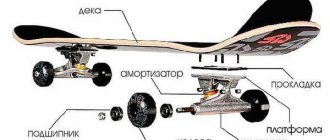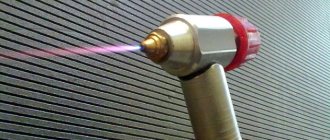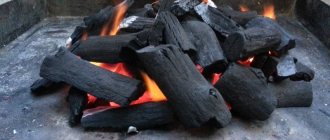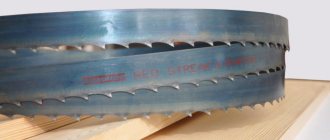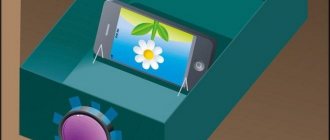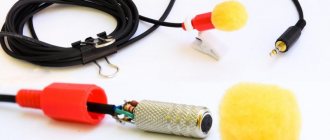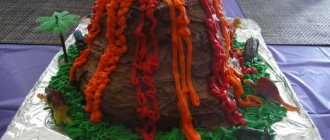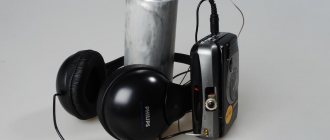This article explains how to make a 3D model of the Moon from scratch. It would seem, Why create a model of the Moon yourself if you can buy it? If only because when you make your own model of the Moon, you will be able to set the desired parameters, for example, the size and thickness of the shell, image resolution, rotation limits, position of the cutting plane, you can make a hole for the lamp, and so on. Let's start creating our own Moon.
You can find a variety of 3D models of the Moon on the Internet. Some can be purchased in online stores, others can be downloaded as files and printed on a 3D printer. Ready-made models can be divided into 2 categories:
- The surface of the Moon is drawn in detail and with high quality, but if you place a light source in the model, its details are not illuminated from the inside.
- Surface details are clearly visible when backlit from the inside, but they are not visible without backlighting.
Step 1. Drawing details
Details are not illuminated from the inside if a light source is placed inside.
Details are clearly drawn when illuminated from within.
If you don't have a 3D printer, you can buy a Moon Lamp online.
Step 2. Preparing software
Below I provide a list of the software involved. After familiarizing yourself with the technique, you can do the same as I did using ordinary tools.
Modeling tools
Download my customized version of Banate CAD from GitHub.
Banate CAD is written in Lua, so to run scripts on Windows, install Lua for Windows.
STL File Editing Tools
Meshmixer
Step 3. Preparing materials
Plastic for printing
The images above are of PLA plastic products. Products produced by 3D printing using different types of white PLA plastic can have different shades. The plastic supplier claims that option B is the best, but unfortunately this is what stuck in my printer.
Light source
The model of the Moon can be illuminated in different ways; the light source can be powered by batteries, from the mains, and so on. The choice of light source is also influenced by the size of the model. There are a lot of options, and if we start discussing them here, we will deviate from the topic of printing. It is enough to understand that there are a lot of options. I would like to note that the warm white light of the source is more pleasant to the eye.
Matte spray paint
Most models made from PLA plastic have pronounced reflective properties, so I recommend making the surface matte. Matte spray paint will easily solve the problem.
Step 4: Moon Images
For the simulation you will need two images of the Moon. They are located in the BanteCAD/Examples folder. I reduced the resolution to 720x360, which should be enough for the model. If necessary, find higher resolution images online.
Relief map
There is a special map for surface modeling, usually called a relief map. The shade of gray indicates the height of the corresponding point on the sphere. Having a relief map allows you to accurately display all surface details on the model. However, if you compare the relief map with the Moon in the sky, you will notice that they are different from each other.
Visual map
The details of the real Moon are not just different heights at different points. Color is also important. Naturally, we can tell the printer to print different colors, but fortunately, we see the real Moon in shades of gray. To allow light to penetrate the model at different intensities, you can print the model with different wall thicknesses and overlay a grayscale image over the model. To adjust the thickness of the model walls, we need a visual map of the Moon.
Post-processing
- A map of the lunar surface is a simple relief map. I need to take the internal thickness into account, so I use the Level function to shift the value to the right (it will show a brighter image on the bump map).
- The inner map of the Moon is the shape of the inner surface of the model. Using this map, we determine the thickness at each point of the surface, that is, the desired shade of gray. This map is built from a visual map, which in turn has thickness parameters applied based on the relief map. Or, to use another calculation method, by subtracting the terrain map from the inverted visual map.
Customizable options
- If you lower the level of the relief map, the elevations on the surface will be smaller and the sag will be reduced, but you will have to distribute the surface details differently.
- If you move the level of the visual map to the left, the shell will become thicker, and vice versa. It is important to remember that you should not move the level too far to the right. The shell must be at least 0.4 mm thick (if using a 0.4 mm extruder nozzle), otherwise you will have to make a hole in the shell by hand.
- The range of the light gray scale depends on the range of levels of the visual map.
Attached files: moon.xcf
Step 5. Control of layer thickness
The shell should not be too thick, but not too thin, so that holes do not form on it in unexpected places, as in the example above. If the shell is thinner than it can be printed, the printer simply won’t print anything, and holes may even form on the surface in unexpected places. This is how you can fix it.
- Open the STL file generated by BanateCAD in Meshmixer.
- Delete the inner surface model.
- Run the Edit command.
- Select the Hollow command.
- Set the thickness to 0.5mm (for a 0.4mm extruder).
- Run the Hollow command again.
- Accept the changes, the thickness of the lunar surface shell is now 0.5 mm.
- Rotation and cutting of the plane are carried out in the same way as in the lunar shell settings.
- Export the STL file.
- Open the lunar shell STL file in Microsoft 3d Builder.
- Eliminate defects.
- Open an STL file of the lunar surface with a shell thickness of 0.5 mm.
- Eliminate defects in the object.
- Select the entire object.
- Accept the changes, the thickness of the lunar shell is now 0.5 mm.
- Export the STL file.
Step 6. Modeling – BanateCAD
BanateCAD can model a 3D shape based on a terrain map. I have posted the corresponding script in the examples folder. It reads a surface map and an interior map of the Moon and then models both shapes. Below are the steps for modeling using BanateCAD:
- Open the BanateCAD.wlua file.
- From the File menu, select Open.
- Open the moonlamp.lua in the Examples folder.
- Optional: change the settings.
- From the Compile menu, select Compile and Render.
- After some time, a 3D model will appear.
- From the File menu, select Export -> Export STL.
- Enter the STL file name and click the save button.
Customizable options
The sphere's output diameter in inches, bump map, and interior map are created based on this parameter:
local outputSize = 3 - inches
Surface height coefficient:
local outputSize = 3 - inches
The resolution should not be greater than the PNG image resolution:
USteps = 720, WSteps = 360,
Step 7: Create a Shell – Meshmixer
Based on molds made in BanateCAD, we can create a shell by subtracting the surface of the internal form from the mold.
Below is a description of the steps to create a shell using Meshmixer:
- Open the exported STL file with Meshmixer.
- Wait until the download completes.
- Select both models in the Object Browser.
- In the left toolbar, select Edit, then select Boolean Difference.
- Wait for the calculation to complete.
- Select the Accept command.
- Wait for the calculation to complete.
- Leave one model in the Object Browser, this will be the lunar shell.
- Save the file.
Paper moon: three-dimensional and in the form of an applique
The night sky always attracts everyone's gaze, regardless of age. Making toys and pictures on the theme of space and star travel on their own will be interesting for any child. Paper crafts with images of the Moon can be used as postcards for Cosmonautics Day, interior elements, themed photography or children's games. To decorate your house with an applique or a three-dimensional model of the Earth's satellite, you need to know how to make the Moon out of paper with your own hands, we will help with this! We provide templates, stencils, ideas, step-by-step photos and video instructions.
Work on a craft can be combined with an educational lecture on the basics of astronomy: tell your child how the Moon was formed, how it revolves around the Earth, and why it sometimes looks like a sickle.
Preparation
To photograph the Moon you will need a tripod. No, not because it’s dark, but because it’s much more difficult to shoot handheld with a telephoto lens, maintain stability, and avoid blur in the frame.
Choose a spot with a clear view of the Moon - go outside the night before to trace the Moon's path across the sky, and you can get an idea of when everything will fall into place.
If you want to take a photo of just the Moon, location doesn't matter much, but adding some foreground can give the photo some context that will help, for example, make the Moon feel very close and large.
Photo: Mikhail Tikhonov
Sometimes the shooting time will depend on certain events, such as an eclipse, but otherwise you can choose the time that works best for your composition. For example, when the Moon rises above the horizon, it will appear huge, especially in a “super Moon” situation.
Moon Templates for Printing and Cutting
The easiest way to create a “lunar” picture is to print out the Moon template and color it, or use it as a stencil to create an applique.
Required materials and tools
To create a drawing or application you will need:
The finished picture can be decorated with “shining” stars made of foil, rhinestones or sparkles.
Space theme coloring book for children to print
Invite children to color a ready-made drawing template. Don't limit yourself to just pencils or paints. You can decorate the image with plasticine or apply pieces of paper using the mosaic technique. Or maybe you want to use several techniques at once to create a holiday drawing. Fantasize, make your wildest ideas come true!
Imagine how bright and juicy these drawings can become:
And here are your favorite children's cartoon characters:
Use these coloring pages about space or find any others. Children love to add color to black and white images.
Applications
Many ideas for crafts from disposable plates are shown here.
Application “Moon” from a disposable plate and colored paper.
For space applications it is better to use a black or dark blue background.
What you need for work
Models are assembled from pre-cut and bent parts. Developments must be printed on paper with a density of 170-200 g/m². This will guarantee the strength and durability of the structure.
For assembly you will need:
- papercraft scans;
- glue (do not use PVA, after drying it will deform the paper);
- brush;
- a needle for applying glue in hard-to-reach places;
- metal ruler;
- sharp scissors or stationery knife;
- dots for pressing folds;
- any flat surface.
In order not to spoil the desktop, you need to put a piece of linoleum, plywood or glass on the surface.
DIY moon model
First, we cut the newspapers into strips and inflate the balloon to the desired size. First, coat half of the ball with glue and glue the newspapers.
Read also: How to make a staircase to the second floor with your own hands from wood with a 90-degree turn.
So, layer by layer until you get 5-6 layers. (you don’t need to dip each piece in glue, you just need to lubricate each subsequent layer with glue).
Then we can move on to the second half. Again we glue 5-6 layers. After the second half is ready, turn it (crosswise) and make another 2-3 layers. (In total, I got about 10 layers, and hang it by the elastic band to dry. PVA glue dries quickly enough, so everything dried out overnight .)
So, when everything is dry, you can pop the ball. We still have 2 holes left that also need to be sealed and dried.
Now we cover everything with toilet paper in 1 layer. I took the cheapest gray paper, i.e. because it is single-layer (3-layer will not work, then the planet turns out to be embossed and the seams from the newspaper are no longer visible. Let it dry.
Don't forget to make the fastening, I made 2 holes and inserted a bent pin.
We draw the contours of the continents and paint with gouache. This is such beauty!
For the Moon we do the same thing, just take into account the size - the Moon is smaller than the Earth . We make craters, I made them from plasticine. I just rolled sausages of different lengths and widths and laid them out in circles. We cover everything with toilet paper (I forgot about this, so it didn’t turn out the way I wanted)
and dry it. First, I painted everything with a silver spray can, and on top with yellow gouache, except for the craters.
Well, I made a rocket from two 2.5 liters. bottles I connected it, covered it with paper, attached rocket launchers from toilet paper rolls and foil, painted it to my liking and, voila! My crafts will decorate the music room along with the crafts of my colleagues. I think the kids will like it)
Good luck! After the holiday I will post photos of the finished hall)
A flowering tree or a tree of love for Valentine's Day It is quite possible to love deeply, reverently and recklessly at kindergarten age. From an early age it is necessary to instill love in children. That's what it's for.
Do-it-yourself herbal dolls Do-it-yourself herbal dolls will help to significantly expand a child’s horizons and develop a sense of responsibility. Like this.
Do you want to get an unusual decoration out of nothing? It's easy to do!
Interesting ideas for a photo corner
First you need to decide on the style in which the photo zone will be decorated. Don’t be afraid to try new ideas and fantasize for the New Year 2022 - even in a limited living space you can create some pretty creative things with your own hands. Find toys, lamps and accessories. Select a central place for the Christmas tree and place all other decorative items around it.
Various materials can be used in a festive photo corner:
- Homemade paper garlands. Wishes for the New Year and happiness look very good, cut out of double-sided colored paper letter by letter and assembled in the form of a colorful garland. Snowflakes of any size are also an excellent decoration. They can be made using 3D technology or simply glued to glass and any objects in the house. The Internet is full of ideas for making interesting decorations from plain paper for the New Year.
- LED lights or string lights are also popular decorations. They can decorate not only a photo zone, but also any place in an apartment or house. In photographs, such garlands look very beautiful and mysterious. Multi-colored LED garlands can be designed in the form of various shapes: stars, arches, animal figures, and hung in door or window openings.
- Rain and multi-colored tinsel made from special foil and plastic are one of the main attributes of the New Year's holiday decoration. A long arched decoration looks amazing and is loved by everyone. For the background, you can use shiny and bright wrapping paper. By adding all this splendor with garlands, we will get unforgettable photos for the New Year.
- Red satin or silk ribbons will also fit perfectly into the decor of the photo zone. You can also add gold color - it goes well with red.
Step-by-step instruction
First, draw a month on cardboard and cut it out. Since we will be making a volumetric month, we will make two such parts. We also cut out strips for the side parts of the Moon. We assemble the structure using tape.
Now we cut the paper into strips. We cut each strip across, getting shaggy parts. We make a large number of such strips and glue them from bottom to top for a month, each next one overlapping the previous one. The more such stripes there are, and the stripes have cuts, the more fluffy and beautiful the month will turn out to be.
Most likely, a child will be bored listening to the monotonous story of adults about space, about scientific achievements in this area, about the prospects that the study of the endless expanses of the Universe opens up for humanity. But the situation can be corrected and the educational activity can be turned into an exciting game. All kids are curious naturalists. They will, of course, be interested in space objects, but words alone are not enough to hold their attention - visualization is needed. And even more so, they will be interested in participating in the creative process themselves.
From such a soft material as plasticine, you can mold absolutely anything, even the integral satellite of planet Earth - the Moon. Usually, kids notice a bright luminous spot in the evening sky and ask their parents about its origin. While doing exciting modeling, you will have the chance to tell your child in detail what the Moon is, where it is and why it changes its shape and location every night.
1. Make the little Moon from a mixture of yellow and orange plasticine, but a small amount of brown will also work. Matches, a ballpoint pen or a pencil will help create miniature craters on the surface of the Earth's satellite. It all depends on the size of the craft.
2. Take pieces of plasticine of prepared shades in arbitrary quantities.
3. Knead them separately in your hands, then combine, but do not mix until the color averages.
4. Roll the resulting mass into a round Moon. This will be a miniature copy of a familiar space object. If you look at the surface of the Moon through a telescope, you can see shadows and spots of different shapes.
5. To sculpt craters, roll out a long thin sausage.
6. Cut it into small portions with a knife.
7. Make holes in the craters using a match or rod.
9. The child must be told why the Moon changes its shape when we observe it in the night sky every day. For this you will need a dark cake.
Read also: How to make a dressing room with your own hands, doors to the dressing room.
10. Place a black shadow on one side of the glowing object. Now the Moon in the sky has become a new moon.
These are the kind of interesting lessons you can practice with children, thanks to the familiar plasticine. From this bright mass it is not difficult to mold even the planets of the solar system.
How to organize a photo zone for the New Year
Choose a couple of primary colors for decoration and a few additional shades as accents. As an option, you can make the entire photo corner in one color. Such minimalistic solutions are now in fashion.
The main colors can be:
- bright blue;
- dark green;
- pale blue;
- golden;
- snow-white;
- silver;
- bright red.
The texture of natural wood and decorations in the form of sparkles and glitters are popular.
Master class on making papier-mâché models of the Earth and Moon for Cosmonautics Day
In summer, the night sky is often clear, allowing you to lie on your back for hours and admire the starry landscape. It’s all uniquely beautiful - the twinkling of distant planets, the subtle sparkle of nearby stars, the deep blackness of space, and the mystical ball of the Moon. Although... why is it unique? The ideal, of course, cannot be achieved, however, it is still possible to come up with something. DIY moon is a project that will help the night sky become a little closer to you. If you are partial to pictures that you can admire when the Sun slides below the horizon, which appear in the sky when the bulk of your neighbors are already having vivid dreams, you should think about how to make the Moon with your own hands . It is exciting, interesting and, in the end, so beautiful that it takes your breath away!
How to make the moon with your own hands - 5 master classes:
Decorations for the photo zone
One of the most popular ideas for designing a photo zone for the New Year 2020 is the theme of family, a hearth, which symbolizes comfort and warmth and can be made with your own hands. To bring it to life, you will need boxes and some other materials that are in every home.
How to make a fireplace from scrap materials
It is not often possible to install a real fireplace in an apartment or house, as this is a rather expensive undertaking. But everyone can make an imitation of a fireplace from those things that are always at hand and please their family with their creativity. Children usually love such activities and will happily take part in preparing the fireplace.
To create a fireplace you will need:
- several cardboard boxes;
- tape, stapler or reliable glue;
- multi-colored paints, colored paper, decorative elements;
- scissors, brushes, ruler, pencils, cardboard cutter.
- Assembling the fireplace will take more than one hour, so it is better to do it on a weekend, without rushing. It is better to take a packaging box from any large-sized equipment or ask at the nearest store. You can make a fireplace out of small gift boxes, such as shoe boxes.
- Choose the decor according to your own taste or by looking for ideas on the Internet.
- The fireplace can be made ordinary or corner, it depends on the sufficient space in the apartment and desire.
- When cutting out a place for the fireplace portal, you need to mark the lines with a pencil and carefully cut the hole with a knife, bending all the parts inward. If the box is large, this will be quite easy to do.
You can decorate a fireplace in several ways:
- The basic idea is to draw classic brickwork, or make an imitation of it from colored paper. From one A4 sheet you can make up to 4 “bricks”.
- An excellent and quick way out is to cover the frame of the fireplace with wallpaper that is made in the form of a brick wall. You just have to buy some wallpaper glue. Although a stapler will also work.
- Polystyrene foam in the form of flat “bricks” glued to the base frame of the fireplace will look very decorative. Moreover, the main color of the coming 2022 is white. Also paint the cardboard base in a milky or light gray shade.
- A great option is to paint the base of the fireplace with snow-white paint. Or cover it with white paper.
How to simulate a burning fire in a fireplace? Creating this effect is quite simple. Here's what you can do:
- If one of the family members is good at drawing, then you can make a drawing of fire and stick it to the appropriate place in the fireplace frame.
- Garlands of yellow and red colors look great. They will shimmer with lights, and the fireplace will be like a real one.
- Such garlands can be decorated with thin transparent fabric for a more natural flame effect. Organza or voile works well.
- Decorate the portal with Christmas tree decorations, tinsel and figurines of New Year's characters.
Now that the fireplace is finished, it's time to think about how to decorate the top. You can search the Internet for many tempting decor ideas; the examples below will help.
Master class on making papier-mâché models of the Earth and Moon for Cosmonautics Day
Master class on making papier-mâché models of the Earth and Moon for Cosmonautics Day
Before Cosmonautics , we were given a task: from each group, a model of the planet to decorate the hall for the holiday. I chose Zelmlya. In general, while we were on sick leave with our child, we also made the Moon and a rocket)
make something )
-here is a ball with a rubber band (when inflated it turns out perfectly round)
- PVA glue (preferably a bucket at once, because a lot of glue is wasted)
-plasticine (for the Moon )
First, we cut the newspapers into strips and inflate the balloon to the desired size. First, coat half of the ball with glue and glue the newspapers.
So, layer by layer until you get 5-6 layers. (you don’t need to dip each piece in glue, you just need to lubricate each subsequent layer with glue).
Then we can move on to the second half. Again we glue 5-6 layers. After the second half is ready, turn it (crosswise) and make another 2-3 layers. (In total, I got about 10 layers, and hang it by the elastic band to dry. PVA glue dries quickly enough, so everything dried out overnight .)
So, when everything is dry, you can pop the ball. We still have 2 holes left that also need to be sealed and dried.
Now we cover everything with toilet paper in 1 layer. I took the cheapest gray paper, i.e. because it is single-layer (3-layer will not work, then the planet turns out to be embossed and the seams from the newspaper are no longer visible. Let it dry.
Don't forget to make the fastening, I made 2 holes and inserted a bent pin.
We draw the contours of the continents and paint with gouache. This is such beauty!
For the Moon we do the same thing, just take into account the size - the Moon is smaller than the Earth . We make craters, I made them from plasticine. I just rolled sausages of different lengths and widths and laid them out in circles. We cover everything with toilet paper (I forgot about this, so it didn’t turn out the way I wanted)
and dry it. First, I painted everything with a silver spray can, and on top with yellow gouache, except for the craters.
Well, I made a rocket from two 2.5 liters. bottles I connected it, covered it with paper, attached rocket launchers from toilet paper rolls and foil, painted it to my liking and, voila! My crafts will decorate the music room along with the crafts of my colleagues. I think the kids will like it)
Good luck! After the holiday I will post photos of the finished hall)
Christmas tree on the wall
This idea is suitable for those who have little space in their apartment, but want a holiday. Also, wall-mounted trees will not be touched by pets, especially curious cats.
A small Christmas tree on the wall looks amazingly elegant. For it you need to take several small wooden blocks or sticks and fix them on the wall in the shape of a New Year's tree. Decorate with any Christmas tree decorations and garland.
When your soul demands a cheerful holiday, and the New Year 2022 is almost on the doorstep, the idea of setting up a winter photo zone will come in handy. Not everyone has a lot of time to think through and decorate the entire interior of the house for the New Year, but everyone can do a small fairy-tale corner with their own hands. Festive photos will preserve the spirit of the New Year for a long time, and if you invite your friends to take photos, the holiday will turn out even more interesting.
How to make a moon out of paper?
You can make the moon out of paper. This will take a few days, but the result is worth it. To make an Earth satellite, you will need:
- 3 sheets of white paper,
- 2 newspapers,
- a little vegetable oil,
- 1 balloon,
- watercolor paints,
- paste,
- glass of water,
- glitter for decoration.
First, inflate a balloon of any size and grease it with vegetable oil. Now you should tear the white paper into small squares, the same should be done with newspapers. Then dip the white squares into water and attach them to the ball. You need to cover the entire balloon in 3 layers.
After this, grease the newspaper squares with paste and glue them to the ball. You need to make at least 15 layers of newspaper squares. It is best to divide this stage into two days. That is, you will make 7 layers today, and 8 tomorrow.
Once you are done with this, you will need to cover the future Moon with three layers of white squares. They need to be smeared with paste and glued to the ball. Now the satellite should dry well. This will take about a week. After this time, you can decorate the Moon with watercolors and decorate it with sparkles.
Read also: How to make a press from a jack with your own hands, drawings, photos.
Sky map
You will need: cardboard base for the layout, acrylic paints in black, purple, blue and silver, brushes, sheets of A4 paper, corrugated paper in yellow and orange, scissors, glue, gouache, water, liquid soap, cocktail tube, white egg shell , rope for hanging.
Master Class
- Paint the cardboard base of the mockup with black acrylic paint.
- Spray blue, purple and silver acrylic paint.
- Draw the orbits of the planets with silver paint.
- Make the sun disk by "cutting" - cut the corrugated paper into small pieces, then glue them tightly together so that they are raised up.
- Paint sheets of paper with gouache to match the colors of the planets.
- To make craters and mottled surfaces for some planets, pour gouache, water and liquid soap into a plate. Take a cocktail tube, blow bubbles and transfer them to paper.
- Wait for the paper to dry, then cut out the planets.
- Glue the shells as ice floes onto Pluto.
- Glue the planets in order to the layout.
- Attach rope for further hanging.
The sky map is ready! I recommend watching this video!
Model of the solar system Planetarium. Solar system planetarium model.
How to learn to draw the Earth's satellite (Moon) with a simple pencil
The mysterious night luminary is the Moon; it has attracted glances at all times. It attracted attention and gave rise to a lot of reasoning and superstitions. We see it either as a crescent, waning or waxing, or as a full moon. The color is mostly gray-silver, with darker crater areas. Therefore, today we will draw the night luminary, the Moon, step by step with a simple pencil.
So, how can a child draw the Moon with a simple pencil?
To work, we will need a landscape sheet, a simple pencil with a softness of 4 B, a kneading pen or an eraser, ready-made shading, or you can use a piece of napkin.
1. First, draw an even circle on a sheet of paper; you can use a compass.
2. Next we apply shading. We shade thickly, first apply one layer of pencil, then slightly changing the angle of the hatching, apply a second layer. Then you need to even out the tone by shading.
3. The next step is to sketch the craters. We draw the lines of the craters uneven, and we also draw the craters themselves in different sizes.
4. Then we begin to additionally shade the areas with craters. We make the boundaries of the crankcases darker, from their main area. We go through them with shading, shade the borders a little so that they are not too clear.
5. The final step is to highlight some areas of the satellite outside the crater so that they are lighter compared to the rest of the bright areas of the Moon. We will also highlight small areas in the area of the craters using a knob or an eraser. And also with a knob or an eraser (thinly cut) we will draw thin stripes, like rays, which will help show the pattern on the Moon and give it the shape of a ball. And now the drawing of the Moon with a simple pencil is completed.
Panel with an unusual surface
If you have a thick cardboard package on hand, for example, pizza, you can create an unusual panel with your own hands. Using this technique, the moon looks like a real one – with a structured surface.
In addition to a box or two sheets of corrugated cardboard, for the craft you need:
- black, blue, purple and white gouache;
- toothbrush and sponge for washing dishes;
- scissors and medical pipette;
- soda and citric acid.
When all the “ingredients” are ready, you can start working. The first step is to create a background for the planet. For it you need to draw a circle on one of the cardboards and cut it out.
Then we will create a starry sky or space in the background. The first layer is black gouache. Then, using a sponge, apply strokes and specks of blue and purple paint. Each layer must dry.
A toothbrush is needed to “scatter” stars across our sky. Dip it in white paint, lower the bristles down and run your finger along them.
We are preparing the second part of the craft. On a whole sheet of cardboard, we draw a circle with our own hands with the same diameter as on the first one. Sprinkle soda on it in an even thick layer - this will be the surface of our moon.
We need to make a solution in a container with water - dilute citric acid (1 tsp of powder per 100 ml of liquid). We take the solution into a pipette and drop it onto a layer of soda. The components react and form a characteristic surface with craters and mountains.
After the entire layer of soda is covered with the solution, you need to wait until the reaction of the components ends and dry the workpiece thoroughly. Then we put the cardboard with the hole on the cardboard with the moon and the craft is ready. You can complement it with decor - foil stars.
Princess Celestia
Celestia is a white, cute horse with almond-shaped eyes. Make her out of white material, similar to Rainbow Dash. Features of making Princess Celestia:
- Make the pony's eyes purple.
- Make the pony's mane and tail from stripes of sea green, blue, green and pink. The green stripe should be the widest.
- Bend the strips to create a wave and connect them in series.
- Glue the green bangs and mane to the head, creating curls at the ends.
- Attach the tail to the body using a match.
- Roll out the yellow plasticine and use the stack to cut out the necklace, crown and patterns for the legs.
- Attach purple diamonds to the necklace and crown.
- Glue on all the decorations. Place the crown on the bangs.
- Make a distinctive sign on the side of the pony: a yellow sun with orange rays. Give the rays the appearance of an arc.
- Make a small white horn and glue it to the center of the head in front of the crown.
- Cover the mane and tail with glitter.
Solar system using felting technique
Felting wool is a new way for craftsmen, but already gaining popularity, to create original crafts.
For work we will need:
- Wool.
- Styrofoam.
- Needles for felting.
- Old nylon tights.
- Liquid soap and water.
- Paper towels.
- Wire and pliers.
Today we are creating Mars. Step-by-step instructions for the master:
- Cut out a small ball from polystyrene foam.
- Prepare red wool, add inclusions of white material.
- We wrap our base ball with red threads. Now you need to wet the workpiece with hot water.
- Drop 3-5 ml of liquid soap onto the workpiece and begin adding wool to the future planet.
- Next, gently roll the ball between your palms.
- Now we lower the workpiece into cold water.
- If necessary, repeat the procedures several times (we focus on the looseness of the material).
- Remove excess moisture with a towel.
Our Mars is ready!
Juravliki.ru
The moon is a feminine symbol and universally represents the rhythm of time. The phases of the moon symbolize immortality, eternity and enlightenment. This page presents a very beautiful and high-quality origami moon model.
| 1. Make folds along the diagonals of the sheet, then fold the sides to the center line as shown | 2. Fold the sides at the bottom in the same way |
| 3. Fold all four sides at the same time | 4. You should get a figure like this, fold its left side back |
| 5. Fold the corner down along the indicated line | 6. Shaping the nose |
| 7. Make a fold, thereby forming the nostrils | 8. Make a fold, turn the model over |
| 9. Bend the corner down | 10. Fold the corner up along the indicated line |
| 11. Make the fold indicated. | 12. Fold the triangle along the indicated line |
| 13. Fold the corners | 14. Fold the outer sides inward, thereby dividing each part in half. |
| 15. | 16. |
| 17. Open this area to narrow your lips. | 18. Fold the top down |
| 19. Fold up using the given link | 20. Raise the indicated area |
| 21. Open the dampers to the position of step 18. | 22. Place the indicated areas inside |
| 23. Pull the paper out of the pocket. Repeat the same at the back. | 24. Pull the edge of the paper on the right and fold it to the side to form an eye. Repeat this at the back. |
| 25. Form a semi-circular shape by making the folds indicated. | 26. Shape the back of the moon to make it an even shape, folding in the excess. |
| Congratulations! Origami moon is ready! |
Lighting
Lighting should also be considered so that all the details of the situation are visible and there are no dark spots or overly lit areas in the photo. Also consider where people will be, so that the light does not blind your eyes and shadows do not fall.
Interesting lighting ideas:
- large star lamps;
- LED garlands in the form of many multi-colored threads;
- garlands on the wall in the shape of a Christmas tree;
- paper lanterns in oriental style;
- decorative candles, lanterns in vintage style.
For candles, you can choose spectacular candelabra or candlesticks decorated with Christmas tree decorations and pine cones.

